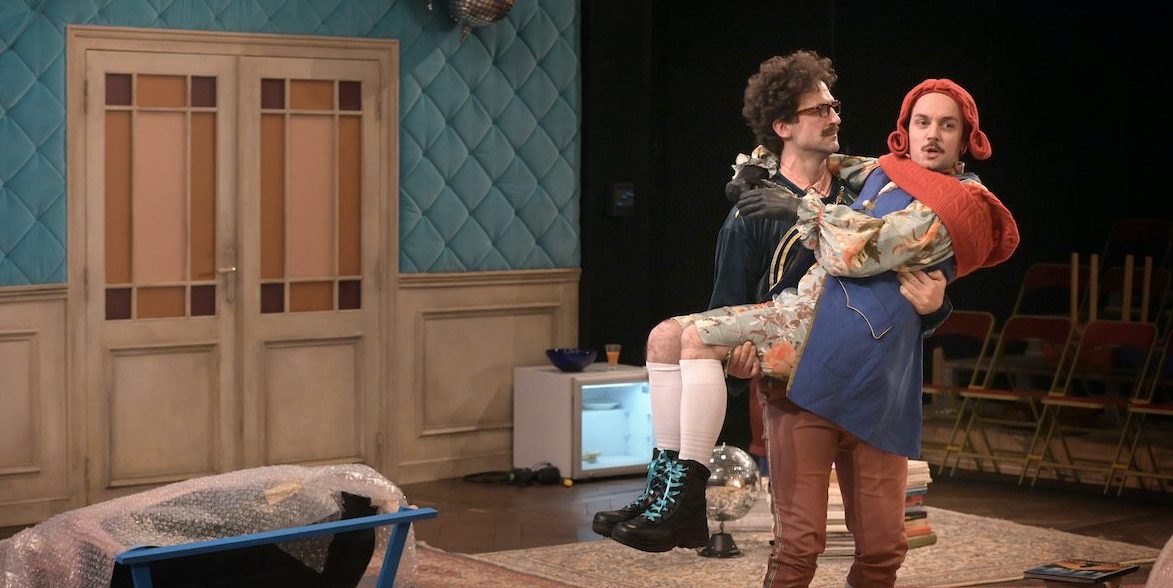Is 2022 the year the Comédie Française goes camp? With Sébastien Pouderoux and Stéphane Varupenne’s new adaptation of Les Précieuses Ridicules, it seems like it is. As part of this season’s homage to Molière, the duo of young actors/directors who gave us a brilliant musical show on Gainsbourg is back with a kitsch and colourful take on Molière’s Précieuses Ridicules, a one-act comedy. As it is sometimes the case at the Vieux Colombier, the public are seated on both sides of the stage and thus have to cross a set covered with various stacks of books: welcome to the world of the ‘précieuses’.
It seems like the duo has a soft spot for satire, dark humour, and most of all hybrid pieces that mix drama and music. Les Précieuses Ridicules fits right in their taste: it is an elaborate satire, a play within a play designed to mock the milieu of the ‘précieuses’ – rich Provincial-to-Parisian women stuck in a bubble of wit and refinery. They love words, art, beauty, and do not want to marry men who are not as refined as them. In this adaptation of the play, Pouderoux and Varupenne transposed this world of 17th century extravagance in a world they know best and they see everyday: influencers, rich people who parade in highly decorated interiors and are elevated as icons by other people.
The set design is one that shows a state of constant performance: over the top, bright blue and pink furniture that reminds of a mix of baroque and bad 80s nostalgia, a fridge with healthy food in it, a musical corner, and books everywhere on the stage. In short: everything seems to point to the fact that they are healthy, cultivated women. The bifrontal arrangement of the seats enhances this state of constant performance that the précieuses are in. They are seen from all sides – and the public is also exposed: one cannot hide from the eyes of the spectators sitting in front of them. Topped with a genius sense of detail – the transparent backpack with fish in it, a Demoiselles de Rochefort poster that appears when the padded wallpaper is torn apart – the overall design is over-the-top like the précieuses, but always precise and justified.
Jérémy Lopez, who has already proven himself to be a great comical actor now also appears to be an improvisational genius. He plays the role of the modest Mascarille, originally played by Molère himself : a less noble man who finds the role of his life when offered to play a nobleman who has to court the précieuses. Both hilarious and touching, he was probably the best choice for the role. The choice of the two actresses Claire de La Rüe du Can and Séphora Pondy was a clever one; they are brilliant as the obnoxious women, and perfectly recreate their absurd wit with the fast, impeccable diction, and mannered moves. They are complementary though Lopez clearly steals the show.
Just like in Pouderoux and Varupenne’s previous play, the musical scenes are very good. Backed up by the musician who also plays the discreet but brilliant character of maid Marotte (alternately Lola Frichet and Edith Séguier) the two directors grab various instruments and play with a stone cold face the tunes that the précieuses performatively dance to. It is during these musical scenes that Jérémy Lopez gives an energy that seems never ending and that the notion of an absurd class performance is best depicted.
As it seems to be fashionable these days, the original play’s ending was changed into a more striking, bitter, and abrupt one. Moliere’s moralist ending is cut off and the spectator is left with a chaotic and explosive ending, a real class struggle onstage. Though it can seem like a blasphemy to change the play’s ending like this, the duo of directors actually makes it work, leaving the spectator wondering if they just saw a comedy or a tragedy while they make their way across the littered stage to find the theater’s exit.

